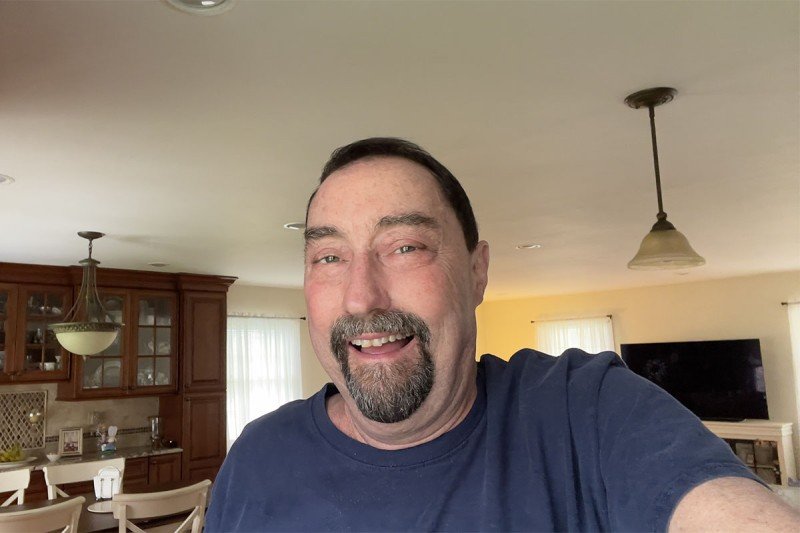
When John Savarese went to see Memorial Sloan Kettering Cancer Center (MSK) hematologic oncologist Doris Ponce for the first time in the fall of 2021, he was not well. “I felt like I was 100 years old,” says the 63-year-old retired air traffic controller and Brooklyn native. “I couldn’t get down on the floor to play with my grandchild. I couldn’t do much of anything.”
John had recently been diagnosed with a condition called graft-versus-host disease (GVHD), a potentially life-threatening complication that often occurs in people who have had a stem cell or bone marrow transplant (BMT) using donor stem cells. With GVHD, the donor’s immune system (called the “graft”) attacks healthy tissues of the recipient (the host).
In 2018, John had received a transplant of stem cells from his sister to treat multiple myeloma, a type of blood cancer, under the care of MSK medical oncologist and hematologist Michael Scordo. But John’s cancer came back, and in February 2020 he enrolled in a clinical trial for an experimental treatment at another hospital.
After being diagnosed with GVHD, John returned to MSK. When he met Dr. Ponce, he knew immediately he was back in the right place. Dr. Ponce is one of the leaders of MSK’s GVHD clinic, a unique, multidisciplinary program that includes not only experts in BMTs but also in dermatology, dental care, rehabilitation medicine, physical therapy, nutrition, nursing, and social work, among other areas. The entire team works together to figure out which treatments are needed for each individual patient. The clinic sees both adults and children, regardless of whether they had their transplant at MSK or another hospital.
Treating a Common Complication of BMTs
“For people who have lethal blood cancers, stem cell transplants can be a lifesaving treatment,” Dr. Ponce says. “But GVHD is a type of immune attack that can cause serious complications.” Between one-third and two-thirds of all people who receive a transplant of donor cells (called an allogeneic transplant) will eventually develop some symptoms of GVHD.
GVHD can be acute, arising within the first few months after the transplant. It can also be chronic, beginning months or even years later and lasting for a long time. It can affect a range of tissues, including the gastrointestinal tract, eyes, skin, liver, and lungs.
In John’s case, his sister’s immune cells were attacking his fascia, the thin sheet of connective tissue that supports and separates the muscles and organs. In particular, they were affecting the fascia around his joints — especially in his wrists, ankles, and knees — making the tissue hard and inflexible and severely limiting his movement. “I felt like I was wrapped up in a bone cocoon,” he says. “I was all tightened up. I didn’t realize how bad it had gotten until the first time I was evaluated in the GVHD clinic and they started asking me detailed questions about my range of motion.”
‘Everyone Here Has Got My Back’
Because GVHD can affect so many organs and systems in the body, many healthcare specialists need to work together to successfully manage each person’s care. In MSK’s GVHD clinic, patients are able see several experts during the same appointment, rather than having to coordinate multiple visits with separate offices. For those who are unable to travel to Manhattan, telemedicine appointments are also available.
MSK’s multidisciplinary GVHD clinic is made up of doctors and nurses who are experts in diagnosing and treating the different forms of GVHD.
Dr. Ponce began treating John with belumosudil (Rezurock™), a drug that rebalances the immune system and is approved to treat GVHD, along with the steroid prednisone. He started feeling better right away. He was also evaluated by other members of the GVHD clinical team, including a physiatrist (a doctor who specializes in physical rehabilitation), a dermatologist, and an ophthalmologist. “This team of doctors and nurses is able to figure out what’s going on and identify the solutions needed to turn things around,” says John, who even received a special shampoo to treat GVHD-related scalp irritation.
John has had to discontinue his treatment for multiple myeloma, which was also causing many severe side effects. But right now, his scans show that his cancer is stable and under control. Since he started treatment for GVHD, his overall health and energy levels have greatly improved, and he’s started rebuilding muscle mass. He’s able to play with his grandchild, and he’s working on his golf swing.
“I did not fully appreciate the level of outstanding service at MSK until I left and came back,” he says. “Memorial Sloan Kettering is at another level. I know everyone here has got my back.”




